Developing Manager: Skills, Performance & Development Plan
VerifiedAdded on 2024/05/21
|23
|4089
|161
Report
AI Summary
This report provides a comprehensive analysis of developing managerial skills within the context of Arosfa Hotel, a local hotel in Central London. It begins by comparing different management styles—autocratic, democratic, and laissez-faire—and discussing their impact on leadership characteristics and employee motivation. The report then evaluates the communication processes within the hotel, including downward, upward, and horizontal communication, and analyzes the organizational culture, considering role, personal, power, task, and hierarchical cultures. A personal SWOT analysis is conducted to assess the manager's strengths, weaknesses, opportunities, and threats, leading to the setting of objectives and targets for personal development. The report further examines leading and motivating a team to achieve goals and justifies managerial decisions made to support these achievements, along with recommendations for improvements. Finally, it explains how managerial and personal skills will support career development and produces a development plan based on a review of career and personal development needs, current performance, and future needs. Desklib offers a variety of solved assignments and past papers for students.

Developing Manager
Paraphrase This Document
Need a fresh take? Get an instant paraphrase of this document with our AI Paraphraser

TABLE OF CONTENTS
Introduction......................................................................................................................................1
LO1..................................................................................................................................................2
1.1 Compare different management styles..................................................................................2
1.2 Discuss leadership characteristics..........................................................................................4
1.3 Evaluate communication process in selected business..........................................................5
1.4 Analyse organizational culture and change in selected business...........................................7
LO2..................................................................................................................................................8
2.1 Assess own management skills performance........................................................................8
2.2 Analyse personal strengths, weaknesses, opportunities and threats......................................9
2.3 Set and priorities objectives and targets to develop own potential......................................10
LO3................................................................................................................................................11
3.1 Lead and motivate a team to achieve an agreed goal or objective......................................11
3.2 Justify managerial decisions made to support achievement of agreed goal or objective and
recommendations for improvements.........................................................................................12
LO4................................................................................................................................................14
4.1 Explain how managerial and personal skills will support career development...................14
4.2 Review career and personal development needs, current performance, and future needs to
produce a development plan......................................................................................................16
Conclusion.....................................................................................................................................17
References......................................................................................................................................18
Introduction......................................................................................................................................1
LO1..................................................................................................................................................2
1.1 Compare different management styles..................................................................................2
1.2 Discuss leadership characteristics..........................................................................................4
1.3 Evaluate communication process in selected business..........................................................5
1.4 Analyse organizational culture and change in selected business...........................................7
LO2..................................................................................................................................................8
2.1 Assess own management skills performance........................................................................8
2.2 Analyse personal strengths, weaknesses, opportunities and threats......................................9
2.3 Set and priorities objectives and targets to develop own potential......................................10
LO3................................................................................................................................................11
3.1 Lead and motivate a team to achieve an agreed goal or objective......................................11
3.2 Justify managerial decisions made to support achievement of agreed goal or objective and
recommendations for improvements.........................................................................................12
LO4................................................................................................................................................14
4.1 Explain how managerial and personal skills will support career development...................14
4.2 Review career and personal development needs, current performance, and future needs to
produce a development plan......................................................................................................16
Conclusion.....................................................................................................................................17
References......................................................................................................................................18

LIST OF FIGURES
Figure 1: Different types of Management Styles.............................................................................2
Figure 2: Communication process...................................................................................................5
Figure 3: Communication Process...................................................................................................6
Figure 4: Strategic Planning..........................................................................................................12
Figure 5: Management and personal skills....................................................................................15
Figure 1: Different types of Management Styles.............................................................................2
Figure 2: Communication process...................................................................................................5
Figure 3: Communication Process...................................................................................................6
Figure 4: Strategic Planning..........................................................................................................12
Figure 5: Management and personal skills....................................................................................15
⊘ This is a preview!⊘
Do you want full access?
Subscribe today to unlock all pages.

Trusted by 1+ million students worldwide
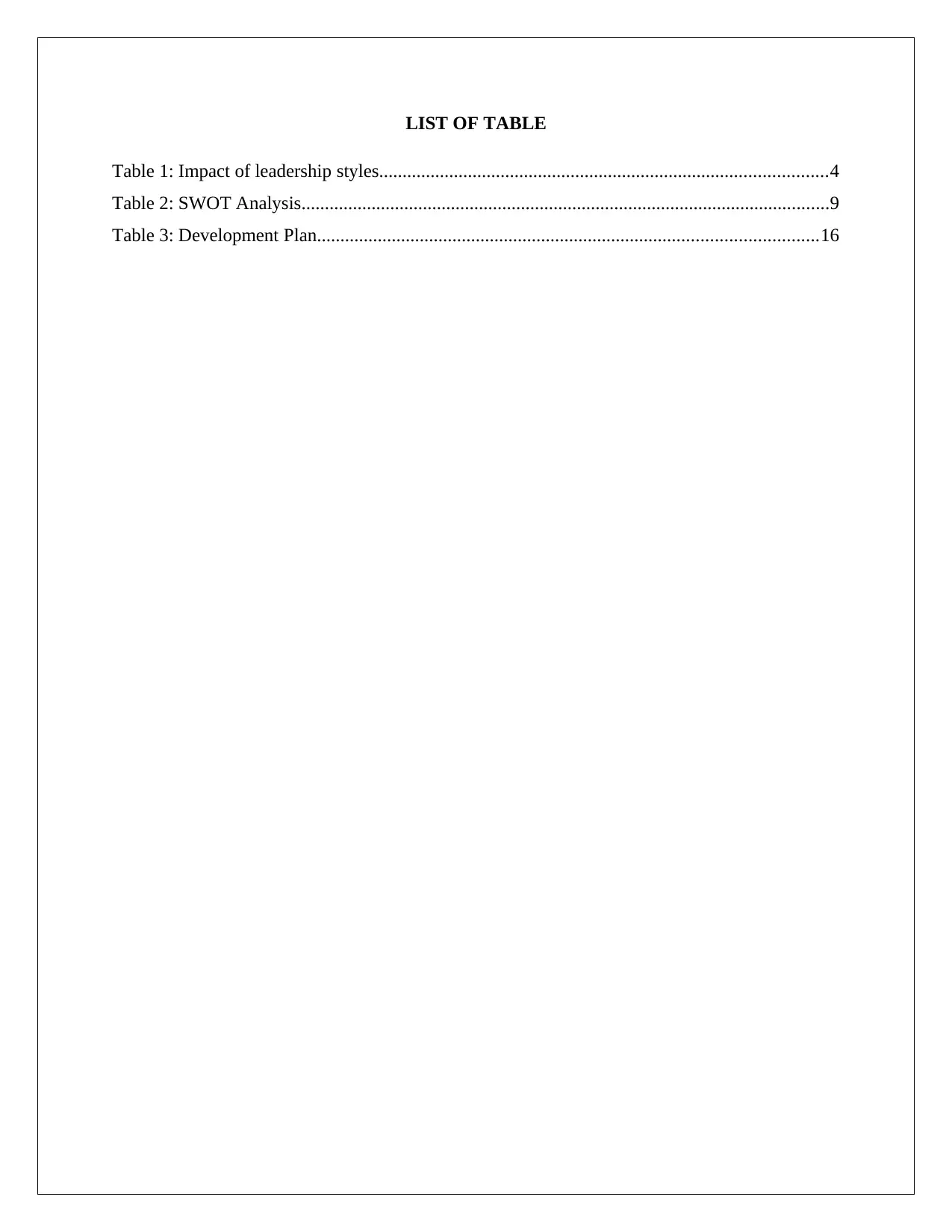
LIST OF TABLE
Table 1: Impact of leadership styles................................................................................................4
Table 2: SWOT Analysis.................................................................................................................9
Table 3: Development Plan...........................................................................................................16
Table 1: Impact of leadership styles................................................................................................4
Table 2: SWOT Analysis.................................................................................................................9
Table 3: Development Plan...........................................................................................................16
Paraphrase This Document
Need a fresh take? Get an instant paraphrase of this document with our AI Paraphraser
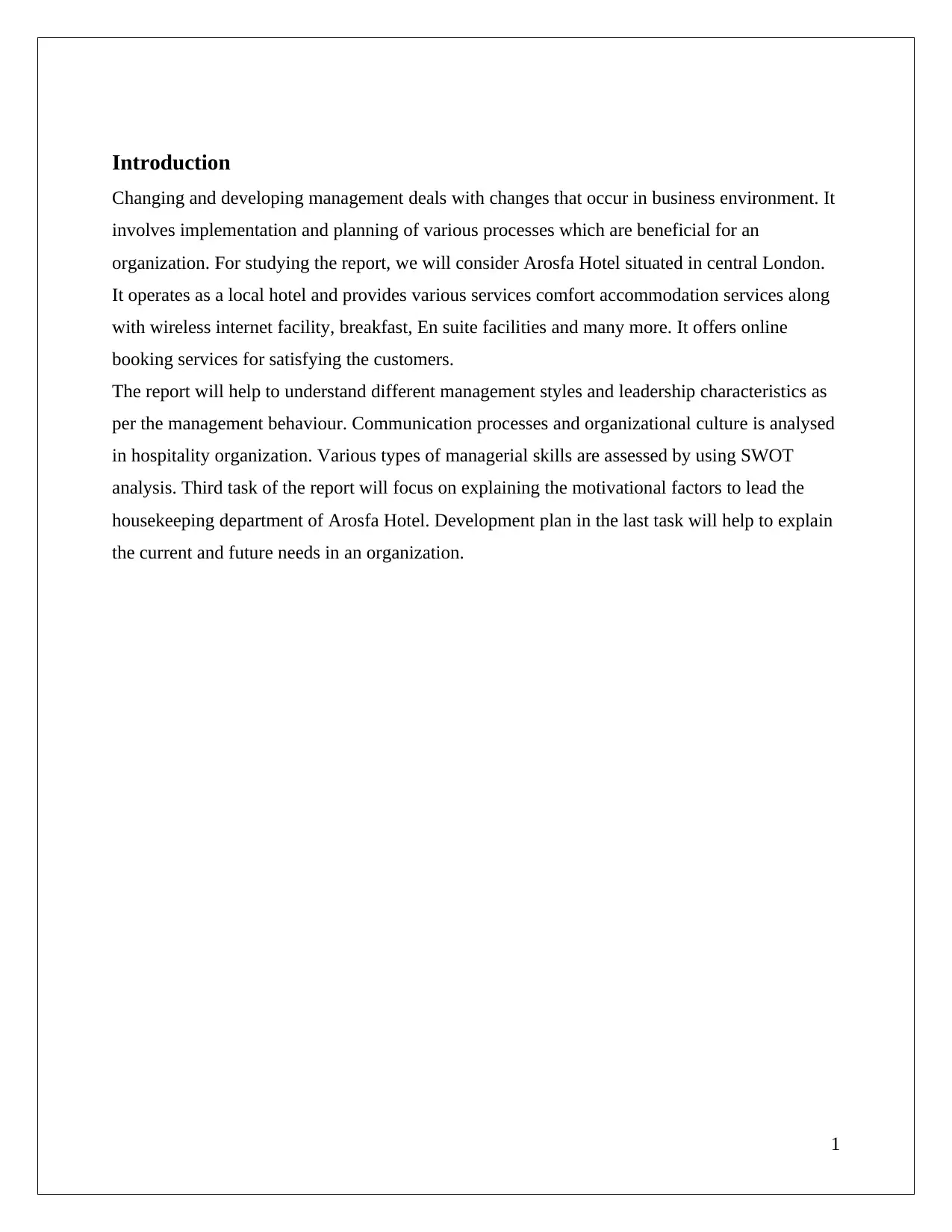
Introduction
Changing and developing management deals with changes that occur in business environment. It
involves implementation and planning of various processes which are beneficial for an
organization. For studying the report, we will consider Arosfa Hotel situated in central London.
It operates as a local hotel and provides various services comfort accommodation services along
with wireless internet facility, breakfast, En suite facilities and many more. It offers online
booking services for satisfying the customers.
The report will help to understand different management styles and leadership characteristics as
per the management behaviour. Communication processes and organizational culture is analysed
in hospitality organization. Various types of managerial skills are assessed by using SWOT
analysis. Third task of the report will focus on explaining the motivational factors to lead the
housekeeping department of Arosfa Hotel. Development plan in the last task will help to explain
the current and future needs in an organization.
1
Changing and developing management deals with changes that occur in business environment. It
involves implementation and planning of various processes which are beneficial for an
organization. For studying the report, we will consider Arosfa Hotel situated in central London.
It operates as a local hotel and provides various services comfort accommodation services along
with wireless internet facility, breakfast, En suite facilities and many more. It offers online
booking services for satisfying the customers.
The report will help to understand different management styles and leadership characteristics as
per the management behaviour. Communication processes and organizational culture is analysed
in hospitality organization. Various types of managerial skills are assessed by using SWOT
analysis. Third task of the report will focus on explaining the motivational factors to lead the
housekeeping department of Arosfa Hotel. Development plan in the last task will help to explain
the current and future needs in an organization.
1
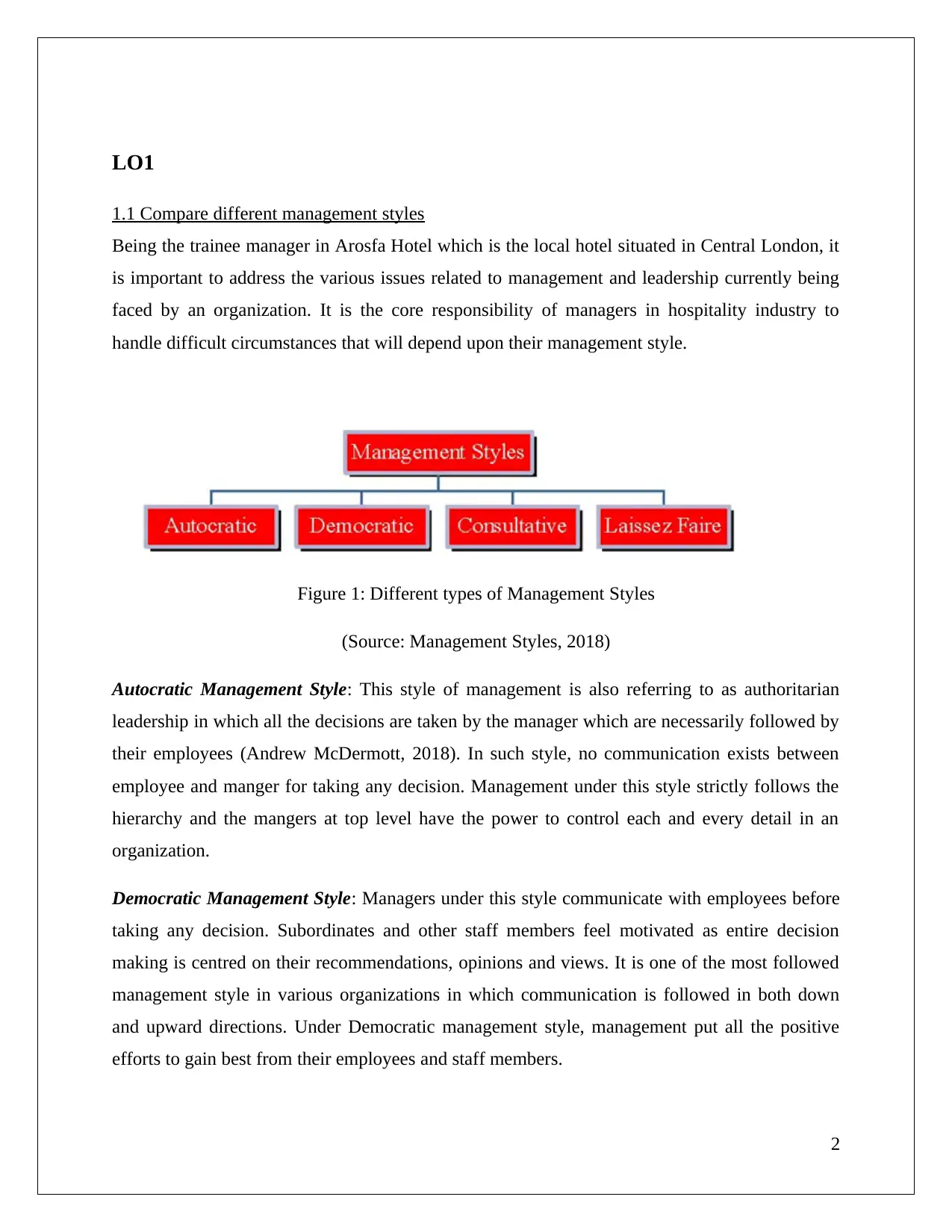
LO1
1.1 Compare different management styles
Being the trainee manager in Arosfa Hotel which is the local hotel situated in Central London, it
is important to address the various issues related to management and leadership currently being
faced by an organization. It is the core responsibility of managers in hospitality industry to
handle difficult circumstances that will depend upon their management style.
Figure 1: Different types of Management Styles
(Source: Management Styles, 2018)
Autocratic Management Style: This style of management is also referring to as authoritarian
leadership in which all the decisions are taken by the manager which are necessarily followed by
their employees (Andrew McDermott, 2018). In such style, no communication exists between
employee and manger for taking any decision. Management under this style strictly follows the
hierarchy and the mangers at top level have the power to control each and every detail in an
organization.
Democratic Management Style: Managers under this style communicate with employees before
taking any decision. Subordinates and other staff members feel motivated as entire decision
making is centred on their recommendations, opinions and views. It is one of the most followed
management style in various organizations in which communication is followed in both down
and upward directions. Under Democratic management style, management put all the positive
efforts to gain best from their employees and staff members.
2
1.1 Compare different management styles
Being the trainee manager in Arosfa Hotel which is the local hotel situated in Central London, it
is important to address the various issues related to management and leadership currently being
faced by an organization. It is the core responsibility of managers in hospitality industry to
handle difficult circumstances that will depend upon their management style.
Figure 1: Different types of Management Styles
(Source: Management Styles, 2018)
Autocratic Management Style: This style of management is also referring to as authoritarian
leadership in which all the decisions are taken by the manager which are necessarily followed by
their employees (Andrew McDermott, 2018). In such style, no communication exists between
employee and manger for taking any decision. Management under this style strictly follows the
hierarchy and the mangers at top level have the power to control each and every detail in an
organization.
Democratic Management Style: Managers under this style communicate with employees before
taking any decision. Subordinates and other staff members feel motivated as entire decision
making is centred on their recommendations, opinions and views. It is one of the most followed
management style in various organizations in which communication is followed in both down
and upward directions. Under Democratic management style, management put all the positive
efforts to gain best from their employees and staff members.
2
⊘ This is a preview!⊘
Do you want full access?
Subscribe today to unlock all pages.

Trusted by 1+ million students worldwide

Laissez management Style: Under such management style, managers show high level of trust on
co workers and employees. Managers rely on employees to a greater extent to increase their
productive by showing confidence in them (Schoar and Zuo, 2017). They follow the hands-off
approach but at the same time they highly support and motivate their employees. Manager who
follows Laissez management style involves themselves in situations when something went
wrong. Team members are instructed to self review and direct their own performance to verify
the outputs and results.
From the above discussion it can be concluded that trainee manager in Arosfa Hotel considers
the Autocratic management style to address the employees of an organization. All the decisions
to a greater extent are taken by the managers and employees on the other hand understand the
need of that decision and co operate with managers by following and implementing the decision.
Mangers in hotel industry as per the need of situation also rely on democratic management style
and involve employees in making critical decision.
3
co workers and employees. Managers rely on employees to a greater extent to increase their
productive by showing confidence in them (Schoar and Zuo, 2017). They follow the hands-off
approach but at the same time they highly support and motivate their employees. Manager who
follows Laissez management style involves themselves in situations when something went
wrong. Team members are instructed to self review and direct their own performance to verify
the outputs and results.
From the above discussion it can be concluded that trainee manager in Arosfa Hotel considers
the Autocratic management style to address the employees of an organization. All the decisions
to a greater extent are taken by the managers and employees on the other hand understand the
need of that decision and co operate with managers by following and implementing the decision.
Mangers in hotel industry as per the need of situation also rely on democratic management style
and involve employees in making critical decision.
3
Paraphrase This Document
Need a fresh take? Get an instant paraphrase of this document with our AI Paraphraser
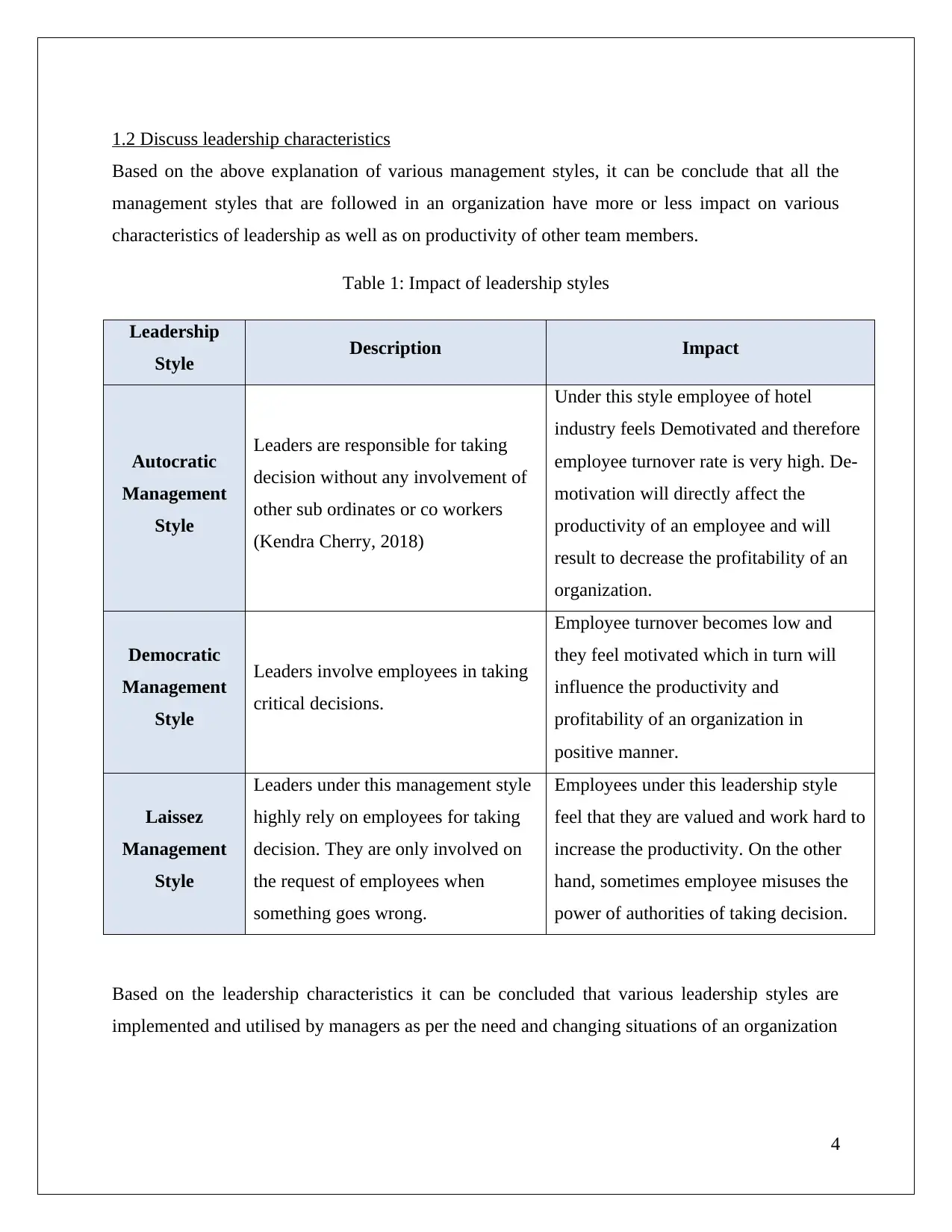
1.2 Discuss leadership characteristics
Based on the above explanation of various management styles, it can be conclude that all the
management styles that are followed in an organization have more or less impact on various
characteristics of leadership as well as on productivity of other team members.
Table 1: Impact of leadership styles
Leadership
Style Description Impact
Autocratic
Management
Style
Leaders are responsible for taking
decision without any involvement of
other sub ordinates or co workers
(Kendra Cherry, 2018)
Under this style employee of hotel
industry feels Demotivated and therefore
employee turnover rate is very high. De-
motivation will directly affect the
productivity of an employee and will
result to decrease the profitability of an
organization.
Democratic
Management
Style
Leaders involve employees in taking
critical decisions.
Employee turnover becomes low and
they feel motivated which in turn will
influence the productivity and
profitability of an organization in
positive manner.
Laissez
Management
Style
Leaders under this management style
highly rely on employees for taking
decision. They are only involved on
the request of employees when
something goes wrong.
Employees under this leadership style
feel that they are valued and work hard to
increase the productivity. On the other
hand, sometimes employee misuses the
power of authorities of taking decision.
Based on the leadership characteristics it can be concluded that various leadership styles are
implemented and utilised by managers as per the need and changing situations of an organization
4
Based on the above explanation of various management styles, it can be conclude that all the
management styles that are followed in an organization have more or less impact on various
characteristics of leadership as well as on productivity of other team members.
Table 1: Impact of leadership styles
Leadership
Style Description Impact
Autocratic
Management
Style
Leaders are responsible for taking
decision without any involvement of
other sub ordinates or co workers
(Kendra Cherry, 2018)
Under this style employee of hotel
industry feels Demotivated and therefore
employee turnover rate is very high. De-
motivation will directly affect the
productivity of an employee and will
result to decrease the profitability of an
organization.
Democratic
Management
Style
Leaders involve employees in taking
critical decisions.
Employee turnover becomes low and
they feel motivated which in turn will
influence the productivity and
profitability of an organization in
positive manner.
Laissez
Management
Style
Leaders under this management style
highly rely on employees for taking
decision. They are only involved on
the request of employees when
something goes wrong.
Employees under this leadership style
feel that they are valued and work hard to
increase the productivity. On the other
hand, sometimes employee misuses the
power of authorities of taking decision.
Based on the leadership characteristics it can be concluded that various leadership styles are
implemented and utilised by managers as per the need and changing situations of an organization
4
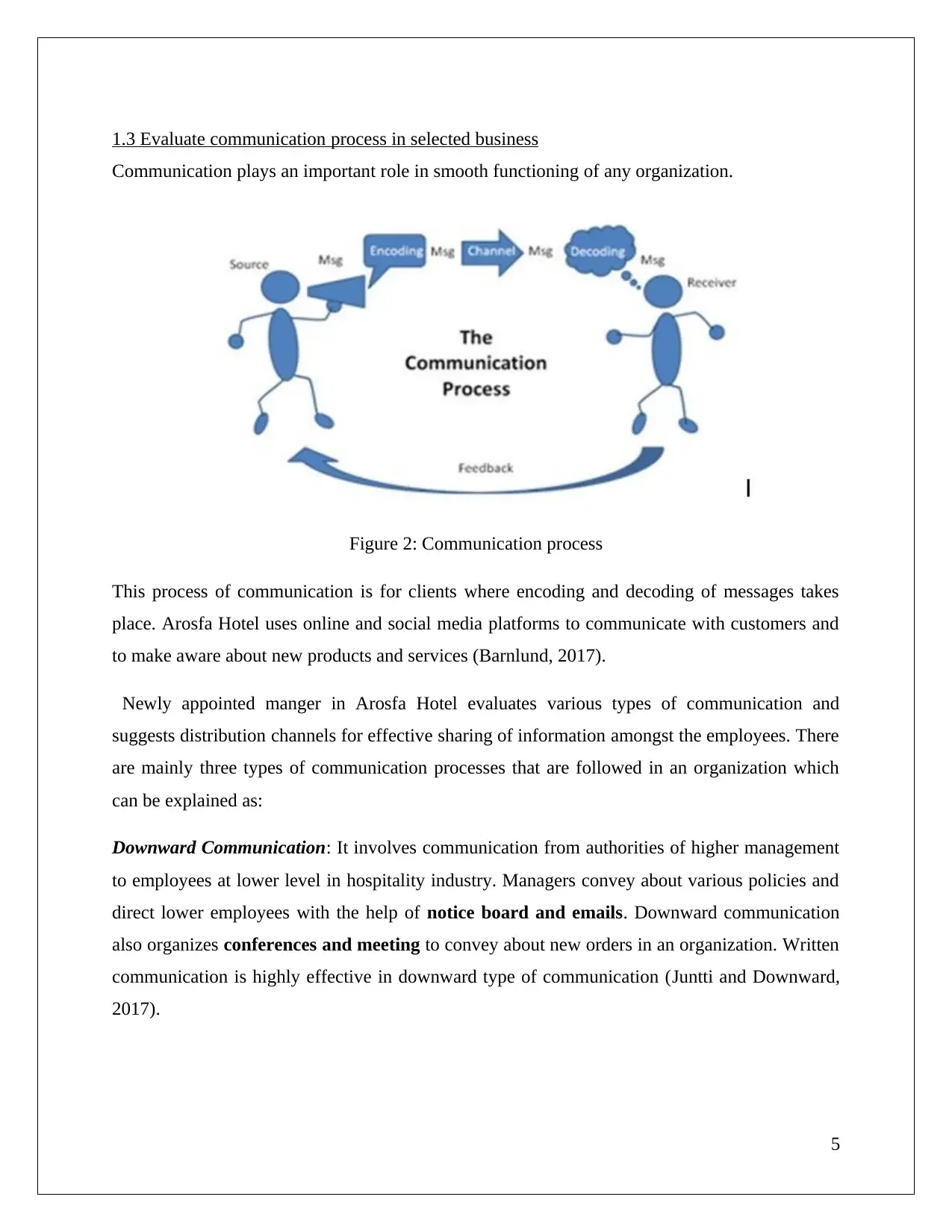
1.3 Evaluate communication process in selected business
Communication plays an important role in smooth functioning of any organization.
Figure 2: Communication process
This process of communication is for clients where encoding and decoding of messages takes
place. Arosfa Hotel uses online and social media platforms to communicate with customers and
to make aware about new products and services (Barnlund, 2017).
Newly appointed manger in Arosfa Hotel evaluates various types of communication and
suggests distribution channels for effective sharing of information amongst the employees. There
are mainly three types of communication processes that are followed in an organization which
can be explained as:
Downward Communication: It involves communication from authorities of higher management
to employees at lower level in hospitality industry. Managers convey about various policies and
direct lower employees with the help of notice board and emails. Downward communication
also organizes conferences and meeting to convey about new orders in an organization. Written
communication is highly effective in downward type of communication (Juntti and Downward,
2017).
5
Communication plays an important role in smooth functioning of any organization.
Figure 2: Communication process
This process of communication is for clients where encoding and decoding of messages takes
place. Arosfa Hotel uses online and social media platforms to communicate with customers and
to make aware about new products and services (Barnlund, 2017).
Newly appointed manger in Arosfa Hotel evaluates various types of communication and
suggests distribution channels for effective sharing of information amongst the employees. There
are mainly three types of communication processes that are followed in an organization which
can be explained as:
Downward Communication: It involves communication from authorities of higher management
to employees at lower level in hospitality industry. Managers convey about various policies and
direct lower employees with the help of notice board and emails. Downward communication
also organizes conferences and meeting to convey about new orders in an organization. Written
communication is highly effective in downward type of communication (Juntti and Downward,
2017).
5
⊘ This is a preview!⊘
Do you want full access?
Subscribe today to unlock all pages.

Trusted by 1+ million students worldwide
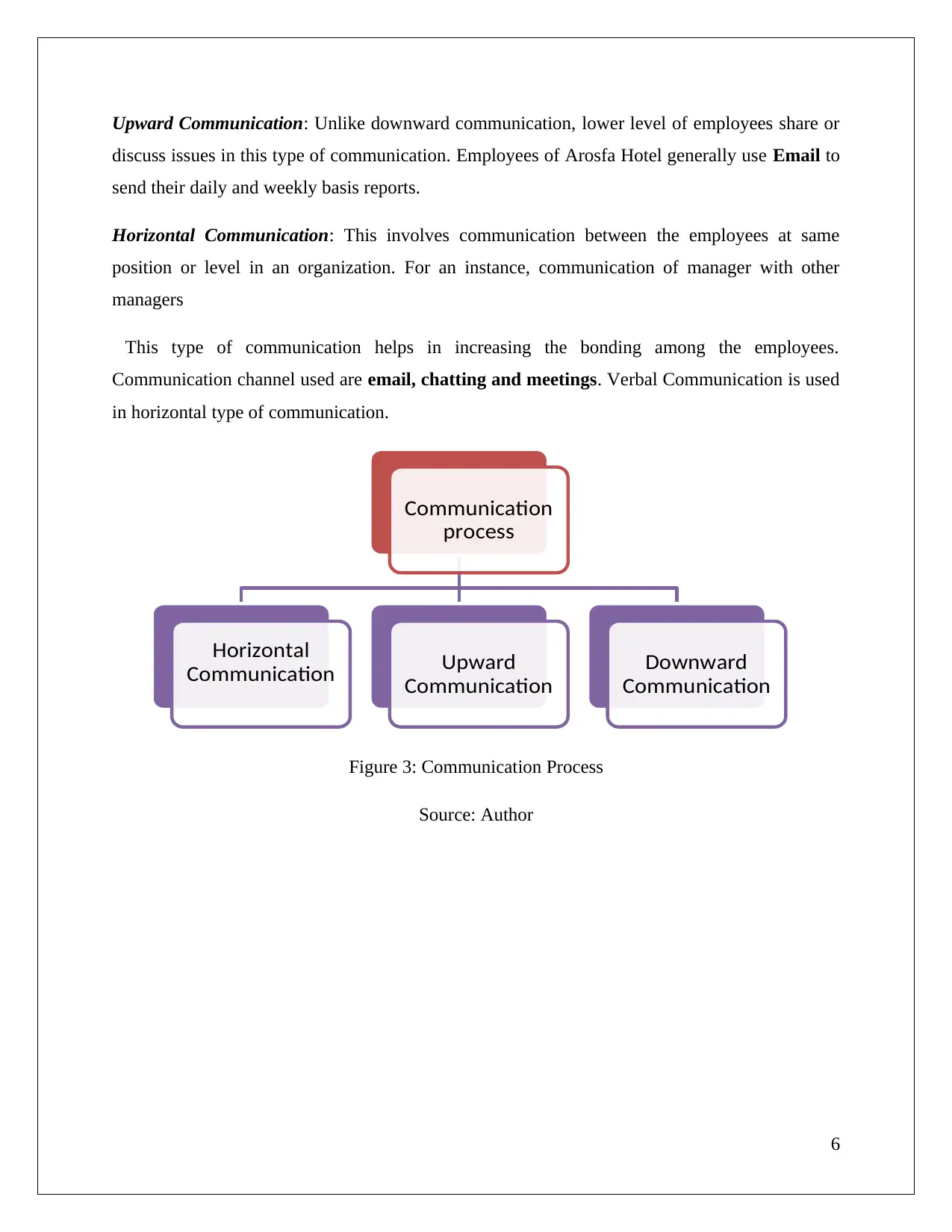
Upward Communication: Unlike downward communication, lower level of employees share or
discuss issues in this type of communication. Employees of Arosfa Hotel generally use Email to
send their daily and weekly basis reports.
Horizontal Communication: This involves communication between the employees at same
position or level in an organization. For an instance, communication of manager with other
managers
This type of communication helps in increasing the bonding among the employees.
Communication channel used are email, chatting and meetings. Verbal Communication is used
in horizontal type of communication.
Figure 3: Communication Process
Source: Author
6
Communication
process
Horizontal
Communication Upward
Communication
Downward
Communication
discuss issues in this type of communication. Employees of Arosfa Hotel generally use Email to
send their daily and weekly basis reports.
Horizontal Communication: This involves communication between the employees at same
position or level in an organization. For an instance, communication of manager with other
managers
This type of communication helps in increasing the bonding among the employees.
Communication channel used are email, chatting and meetings. Verbal Communication is used
in horizontal type of communication.
Figure 3: Communication Process
Source: Author
6
Communication
process
Horizontal
Communication Upward
Communication
Downward
Communication
Paraphrase This Document
Need a fresh take? Get an instant paraphrase of this document with our AI Paraphraser
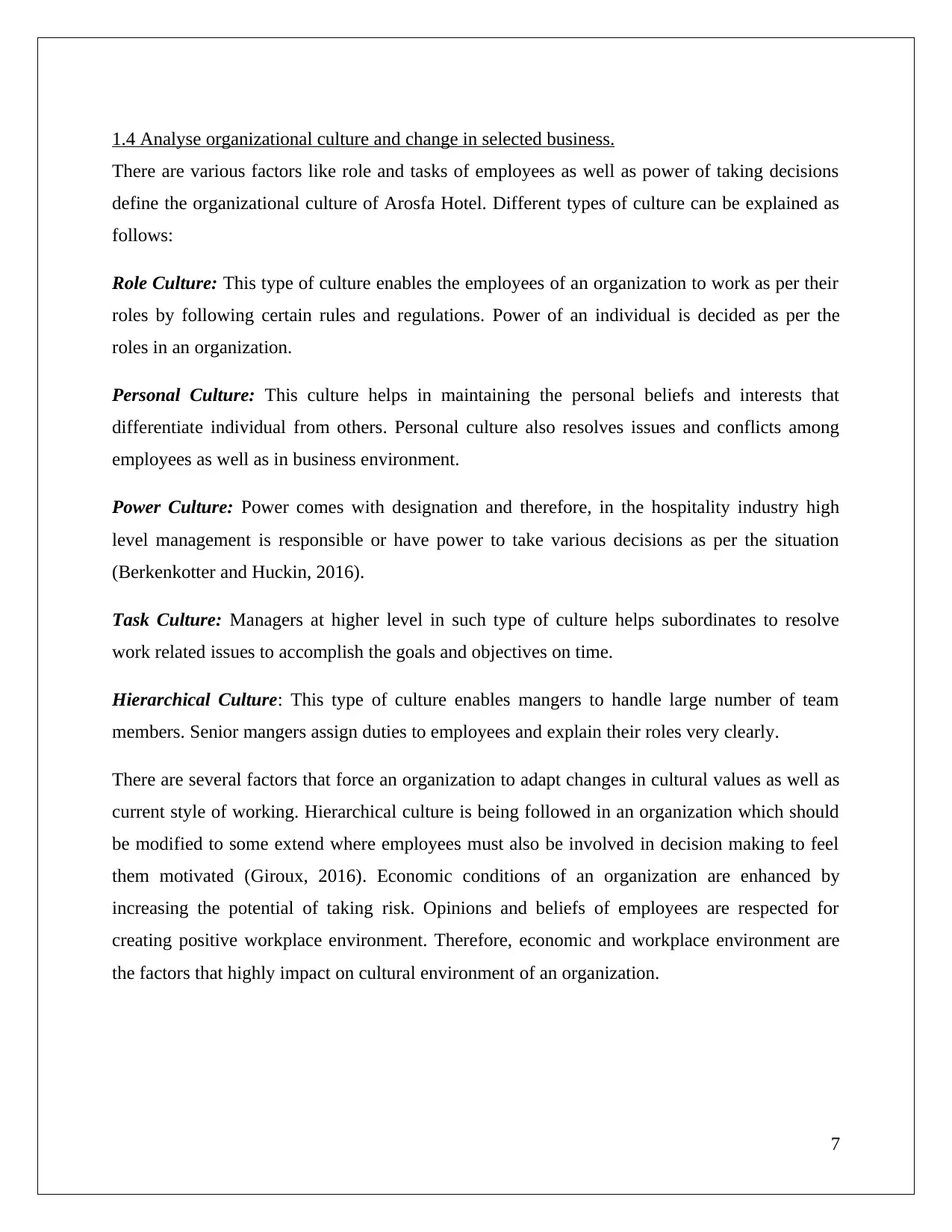
1.4 Analyse organizational culture and change in selected business.
There are various factors like role and tasks of employees as well as power of taking decisions
define the organizational culture of Arosfa Hotel. Different types of culture can be explained as
follows:
Role Culture: This type of culture enables the employees of an organization to work as per their
roles by following certain rules and regulations. Power of an individual is decided as per the
roles in an organization.
Personal Culture: This culture helps in maintaining the personal beliefs and interests that
differentiate individual from others. Personal culture also resolves issues and conflicts among
employees as well as in business environment.
Power Culture: Power comes with designation and therefore, in the hospitality industry high
level management is responsible or have power to take various decisions as per the situation
(Berkenkotter and Huckin, 2016).
Task Culture: Managers at higher level in such type of culture helps subordinates to resolve
work related issues to accomplish the goals and objectives on time.
Hierarchical Culture: This type of culture enables mangers to handle large number of team
members. Senior mangers assign duties to employees and explain their roles very clearly.
There are several factors that force an organization to adapt changes in cultural values as well as
current style of working. Hierarchical culture is being followed in an organization which should
be modified to some extend where employees must also be involved in decision making to feel
them motivated (Giroux, 2016). Economic conditions of an organization are enhanced by
increasing the potential of taking risk. Opinions and beliefs of employees are respected for
creating positive workplace environment. Therefore, economic and workplace environment are
the factors that highly impact on cultural environment of an organization.
7
There are various factors like role and tasks of employees as well as power of taking decisions
define the organizational culture of Arosfa Hotel. Different types of culture can be explained as
follows:
Role Culture: This type of culture enables the employees of an organization to work as per their
roles by following certain rules and regulations. Power of an individual is decided as per the
roles in an organization.
Personal Culture: This culture helps in maintaining the personal beliefs and interests that
differentiate individual from others. Personal culture also resolves issues and conflicts among
employees as well as in business environment.
Power Culture: Power comes with designation and therefore, in the hospitality industry high
level management is responsible or have power to take various decisions as per the situation
(Berkenkotter and Huckin, 2016).
Task Culture: Managers at higher level in such type of culture helps subordinates to resolve
work related issues to accomplish the goals and objectives on time.
Hierarchical Culture: This type of culture enables mangers to handle large number of team
members. Senior mangers assign duties to employees and explain their roles very clearly.
There are several factors that force an organization to adapt changes in cultural values as well as
current style of working. Hierarchical culture is being followed in an organization which should
be modified to some extend where employees must also be involved in decision making to feel
them motivated (Giroux, 2016). Economic conditions of an organization are enhanced by
increasing the potential of taking risk. Opinions and beliefs of employees are respected for
creating positive workplace environment. Therefore, economic and workplace environment are
the factors that highly impact on cultural environment of an organization.
7
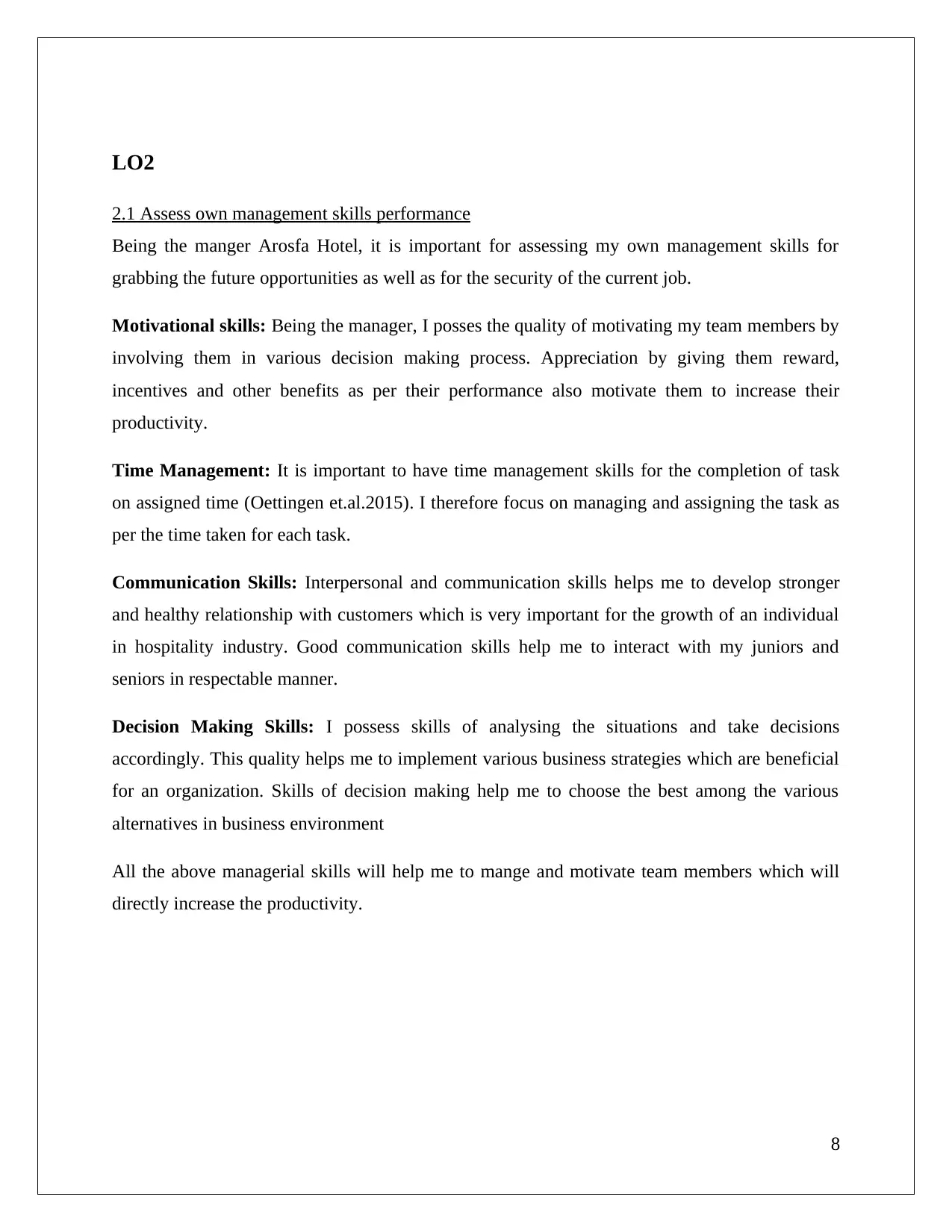
LO2
2.1 Assess own management skills performance
Being the manger Arosfa Hotel, it is important for assessing my own management skills for
grabbing the future opportunities as well as for the security of the current job.
Motivational skills: Being the manager, I posses the quality of motivating my team members by
involving them in various decision making process. Appreciation by giving them reward,
incentives and other benefits as per their performance also motivate them to increase their
productivity.
Time Management: It is important to have time management skills for the completion of task
on assigned time (Oettingen et.al.2015). I therefore focus on managing and assigning the task as
per the time taken for each task.
Communication Skills: Interpersonal and communication skills helps me to develop stronger
and healthy relationship with customers which is very important for the growth of an individual
in hospitality industry. Good communication skills help me to interact with my juniors and
seniors in respectable manner.
Decision Making Skills: I possess skills of analysing the situations and take decisions
accordingly. This quality helps me to implement various business strategies which are beneficial
for an organization. Skills of decision making help me to choose the best among the various
alternatives in business environment
All the above managerial skills will help me to mange and motivate team members which will
directly increase the productivity.
8
2.1 Assess own management skills performance
Being the manger Arosfa Hotel, it is important for assessing my own management skills for
grabbing the future opportunities as well as for the security of the current job.
Motivational skills: Being the manager, I posses the quality of motivating my team members by
involving them in various decision making process. Appreciation by giving them reward,
incentives and other benefits as per their performance also motivate them to increase their
productivity.
Time Management: It is important to have time management skills for the completion of task
on assigned time (Oettingen et.al.2015). I therefore focus on managing and assigning the task as
per the time taken for each task.
Communication Skills: Interpersonal and communication skills helps me to develop stronger
and healthy relationship with customers which is very important for the growth of an individual
in hospitality industry. Good communication skills help me to interact with my juniors and
seniors in respectable manner.
Decision Making Skills: I possess skills of analysing the situations and take decisions
accordingly. This quality helps me to implement various business strategies which are beneficial
for an organization. Skills of decision making help me to choose the best among the various
alternatives in business environment
All the above managerial skills will help me to mange and motivate team members which will
directly increase the productivity.
8
⊘ This is a preview!⊘
Do you want full access?
Subscribe today to unlock all pages.

Trusted by 1+ million students worldwide
1 out of 23
Related Documents
Your All-in-One AI-Powered Toolkit for Academic Success.
+13062052269
info@desklib.com
Available 24*7 on WhatsApp / Email
![[object Object]](/_next/static/media/star-bottom.7253800d.svg)
Unlock your academic potential
Copyright © 2020–2025 A2Z Services. All Rights Reserved. Developed and managed by ZUCOL.



